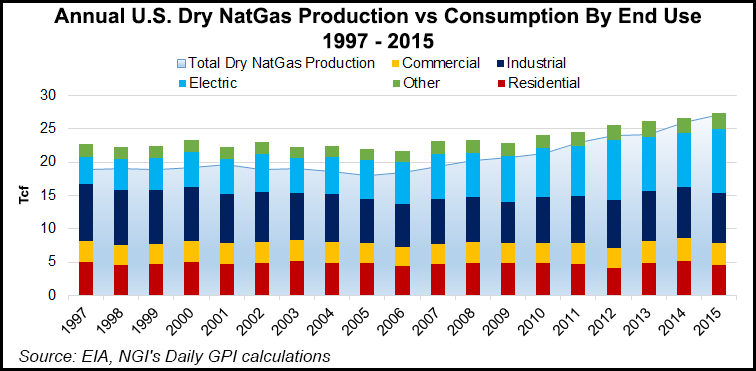Utica Shale | E&P | Marcellus | NGI All News Access
Marcellus, Utica Helped Push U.S. NatGas Production To Record High in 2015, EIA Says
U.S. natural gas production reached a record high in 2015 for the fifth consecutive year, and U.S. consumption levels set a new record for the sixth consecutive year, the Energy Information Administration (EIA) said Friday.

Domestic dry natural gas production was 27.1 Tcf (74.1 Bcf/d) last year, a 4.5% increase compared with 25.9 Tcf (71.0 Bcf/d) in 2014 (see Daily GPI, Oct. 1, 2015), EIA said in its 2015 Natural Gas Annual report.
For the third consecutive year, Pennsylvania, home of the might Marcellus Shale, saw the largest total gain in annual production, increasing to 13.04 Bcf/d in 2015, compared with 11.56 Bcf/d in 2014 to 13.04 Bcf/d. And production in Ohio, dominated by the Utica Shale, increased the most, percentage-wise, of any state, for the second consecutive year, reaching 2.62 Bcf/d in 2015, doubling from 1.31 Bcf/d in 2014.
EIA previously reported that the world’s top producer of petroleum and natural gas hydrocarbons in 2015 was, once again, the United States (see Daily GPI, May 23). U.S. petroleum and natural gas production first surpassed Russian production in 2012 (see Daily GPI, June 13, 2013). The United States has been the world’s top producer of natural gas since 2011 and the world’s top producer of petroleum hydrocarbons since 2013, EIA said.
At the same time, total natural gas consumption continued its upward trend, reaching a record high 27.3 Tcf (74.8 Bcf/d), compared with 26.6 Tcf in 2014. Deliveries to consumers in 2015 were also at a record level of 25.1 Tcf (68.6 Bcf/d), an increase of 2.8% from 2014 deliveries.
“Deliveries to the electric power sector increased by 18.7% in 2015 to a record level of 26.5 Bcf/d,” EIA said. “Deliveries of natural gas used as vehicle fuel also increased (by 11.6%) in 2015. Increases in these two sectors were offset by decreases in deliveries to the residential, commercial, and industrial sectors, which dropped by 9.4%, 7.7%, and 1.5%, respectively, from 2014 levels.”
The small gap between natural gas production and consumption levels was made up through imports, which increased in 2015 year-to-year for the first time since 2007, EIA said. Total imports last year were 2.7 Tcf, an increase of 0.8% compared with 2014. At the same time, exports increased year-to-year for the first time since 2012, from 1.5 Bcf in 2014 to 1,783 Bcf in 2015, an increase of 17.8%.
The EIA said there were 555,364 producing gas wells at the end of 2015, down 1.9% from the 565,951 wells producing at the end of 2014.
In a separate report released on Friday, EIA said gross production of natural gas was 87.41 Bcf/d in July, a 1.8% decline compared with 88.97 Bcf/d in July 2015.
Production increased compared to July 2015 in seven states: Alaska (7.72 Bcf/d, compared with 7.14 Bcf/d in June 2015), Louisiana (5.23 Bcf/d, compared with 4.86 Bcf/d), New Mexico (3.58 Bcf/d, compared with 3.53 Bcf/d), North Dakota (1.69 Bcf/d, compared with 1.66 Bcf/d), Ohio (3.79 Bcf/d, compared with 2.85 Bcf/d), Pennsylvania (14.31 Bcf/d, compared with 12.96 Bcf/d), and West Virginia (3.91 Bcf/d, compared with 3.71 Bcf/d).
States reporting production decreases in July compared with the same month last year included Arkansas (2.20 Bcf/d, compared with 2.75 Bcf/d), California (567 MMcf/d, compared with 620 MMcf/d), Colorado (4.59 Bcf/d, compared with 4.60 Bcf/d), Kansas (680 MMcf/d, compared with 756 MMcf/d), Montana (141 MMcf/d, compared with 159 MMcf/d), Oklahoma (6.80 Bcf/d, compared with 7.00 Bcf/), Texas (22.06 Bcf/d, compared with 24.31 Bcf/d), Utah (988 MMcf/d, compared with 1.18 MMcf/d) and Wyoming (4.40 Bcf/d, compared with 5.40 Bcf/d).
The Federal Gulf of Mexico (3.23 Bcf/d, compared with 3.81 Bcf/d) and EIA’s Other States category (1.53 Bcf/d, compared with 1.65 Bcf/d) also reported declines, EIA said.
© 2024 Natural Gas Intelligence. All rights reserved.
ISSN © 2577-9877 | ISSN © 2158-8023 |
